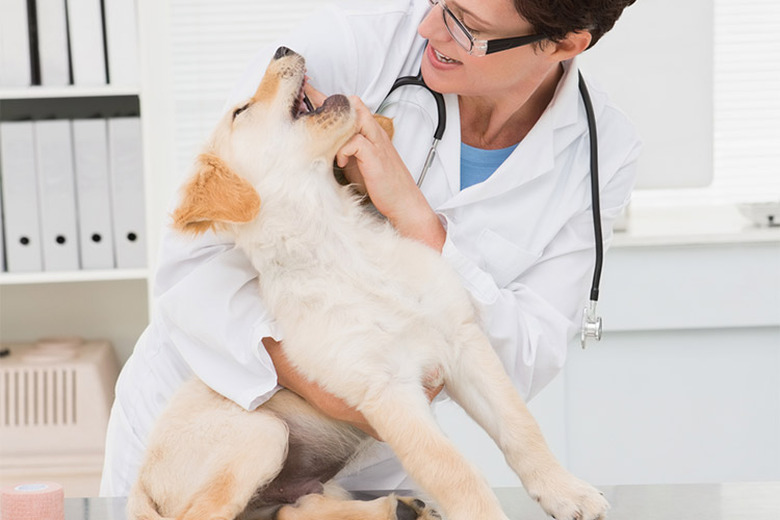My Puppy Has Two Sets Of Canines
If your puppy's fangs have you seeing double, it's likely because the baby teeth didn't fall out on schedule as the permanent tooth erupted. While puppies might retain other teeth, the deciduous upper canines, or fangs, are most likely to stay put. If you notice two sets of puppy fangs, it's best to take your pet to the vet for an extraction of the retained canines.
Deciduous Teeth
Your puppy was born toothless, but by the time he was 3 weeks old his deciduous teeth, also known as milk teeth or baby teeth, started erupting. First come the incisors, followed by the fangs (which they use to grab and puncture food or objects) and then the rest. All of his baby teeth, 28 of them, should be in place by the time he's 6 weeks old.
Adult Teeth
Around 3 months of age, adult teeth begin erupting. That's when that terrible teething stage begins — when puppies chew on anything and everything and no shoes are safe. As the adult teeth come through the gums, the deciduous teeth should fall out. If a baby tooth doesn't fall out, the adult tooth may come in at a strange angle or an odd position. When the entire process finishes, at the age of 6 or 7 months, the dog has 42 adult teeth. Puppies don't have molars, used for grinding.
Retained Teeth Issues
If retained teeth aren't removed, various problems ensue. Your dog might develop periodontal disease, since the presence of two teeth in the same spot causes food-particle collection. Retained teeth are more likely to develop painful abscesses. They also cause malocclusion or defective bite. This can result in jaw and tongue problems. While any dog might retain teeth, it appears to have a genetic component. Toy dogs and brachycephalic, or short-nosed breeds, are more likely to retain teeth. The latter include breeds such as the pug, bulldog and Pekingese.
Treatment
You've been taking your puppy to the vet regularly for checkups. At each visit, your vet checks your pup's mouth to make sure the teeth are coming in properly; once adult teeth erupt, the deciduous teeth aren't retained. If she spots a retained tooth, she can make arrangements to have it pulled. Since many vets wait until a dog is 6 months of age, after the full set of adult have emerged, before pulling retained teeth, you might want to coordinate spaying or neutering — and the need for anesthesia — with tooth extraction.
By Jane Meggitt
References
American Kennel Club: Ask AKC
VCA Animal Hospitals: Retained Teeth in Dogs
University of Kentucky: Veterinary Dentistry Tooth Extraction
Veterinary Partner: Retained Deciduous Teeth
petMD: Retained Baby Teeth in Dogs
DVM360: Tooth Eruption and Exfoliation in Dogs and Cats
About the Author
Jane Meggitt has been a writer for more than 20 years. In addition to reporting for a major newspaper chain, she has been published in "Horse News," "Suburban Classic," "Hoof Beats," "Equine Journal" and other publications. She has a Bachelor of Arts in English from New York University and an Associate of Arts from the American Academy of Dramatics Arts, New York City.
